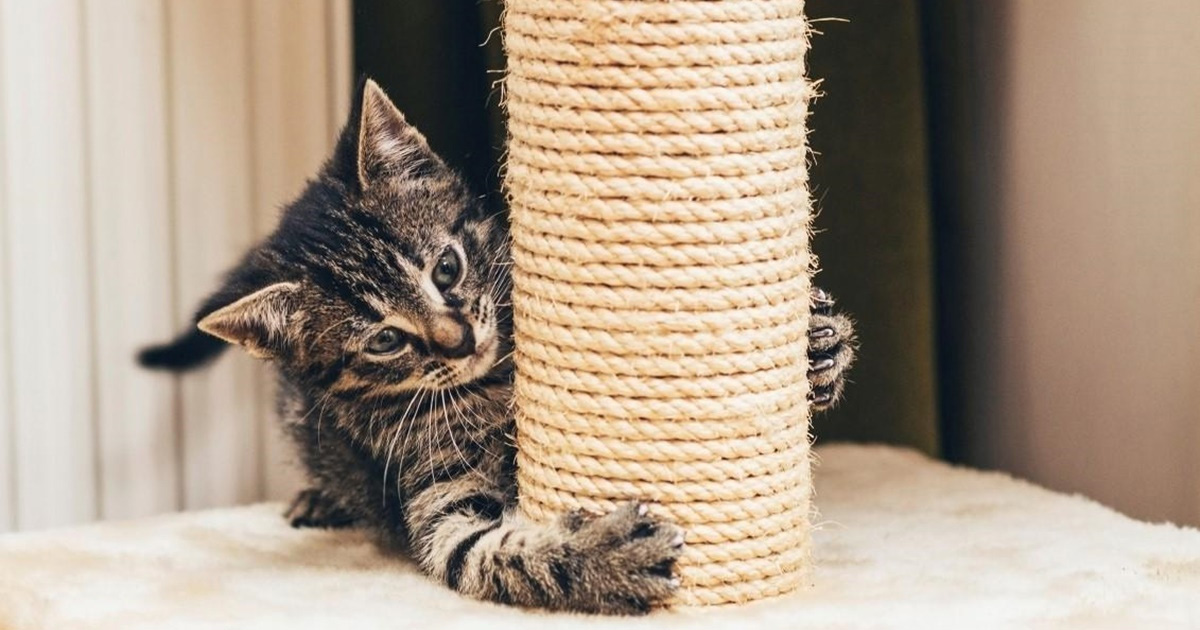4 Ways to Save Your Sofa

No one wants to come home to find the sofa shredded up like Freddy Krueger’s beach towel, and it’s easy to imagine your cat’s sinister grin as she curled up for a nap after wiping a few fluffy strands of stuffing from her mouth. But far from a personal vendetta, your cat’s scratching is natural behavior that’s important to her health, and there are several ways to make sure the cat and the curtains peacefully coexist.
Recognize and Refocus
She may seem fueled by a mischievous fetish for shredding rare vintage sofas, but there’s a more logical reason for your cat’s destructive scratching: it’s her way of keeping her claws honed, marking territory, and stretching her body. Marking your territory? That’s easy. Eight foot privacy fence. Staying fit and limber? Power Vinyasa Class. Your cat needs these too, and has evolved with an effective set of claws to do both.
So instead of heading off to work giving your cat the option between a vintage mid century sofa and your grandmother’s heirloom pillows, provide one or more scratching posts. Choose a sturdy design as tall as your cat when she stands on her hind paws, and with a coarse surface similar to tree bark – the natural surface cats evolved using. Placing scratching posts near problem furniture like her favorite chair or table can help make the transition stick. Rub catnip or catnip oil to make the post more inviting, and if your cat is more of a visual learner, a demonstration may be in order. There’s no shame in getting down on all fours and giving the post a hearty scratch. Flash those incisors and really get into it, you’ll rest easy knowing the new curtains will be intact.
Your boyfriend might want to take some time apart though.
Put the Kibosh on It
Just like a stern look or sharp word from dad was all you needed to reconsider going for the cookie jar before dinner, your cat may get it when he hears a strong “NO!” every time he starts creeping toward that chair. A blast of water delivered by a squirt bottle also gets the point across, and mixing in citrus or eucalyptus oil makes it even more effective. Kinder, gentler souls might feel better clapping or rattling a can of loose change instead, but no matter what method you consistently choose, remember to follow up with positive reinforcement. Take the cat over to the scratching post and lavish praise that would satisfy a Roman Emperor, and he just might make the connection and go for the post next time.
Limit Access
Just like grandma kept those snow white sofas hermetically sealed against your peanut butter and jelly smeared fingers, it might be as simple as covering problem furniture with plastic. Cats hate the smell of plastic and sensation of walking on it. They also dislike the sticky feeling of tape on the sensitive pads of their paws, and contact sheets or double-sided tape strategically placed on furniture and carpets can make that scratching post seem a lot more inviting. Also consider placing special antiques or heirloom furniture in a cat free zone and make sure everyone, including guests, get the memo that kitty stays out.
Take the Edge Off
We need to keep our own nails trimmed. Whether you bite them while nervously contemplating your first bungee jump, or sipping martinis with your girlfriends as your cuticles are buffed to perfection at a boutique nail bar, it has to be done. Since much of the reason your cat scratches is to shorten and hone her claws, you can curb unwanted scratching by simply keeping her nails clipped. There is an art to this, though, and potential for harm if not done correctly. You may feel more comfortable asking your vet for a demonstration the first time. Declawing Surgery might seem like the easiest path to a home with intact sofas and drapes, but talk with your vet first about the pros and cons of the surgery. The citrus oil spray bottle or grandma’s zippered plastic sofa covers might be a better choice if your cat spends a lot of time outdoors or loves to climb his favorite tree.